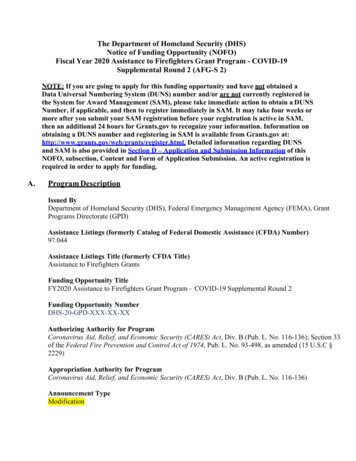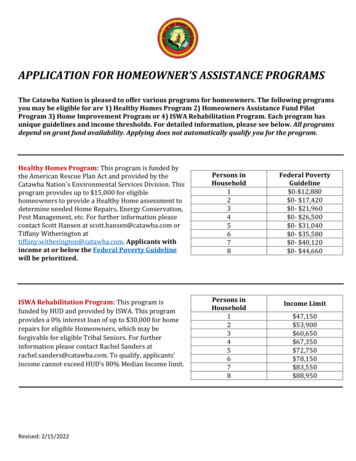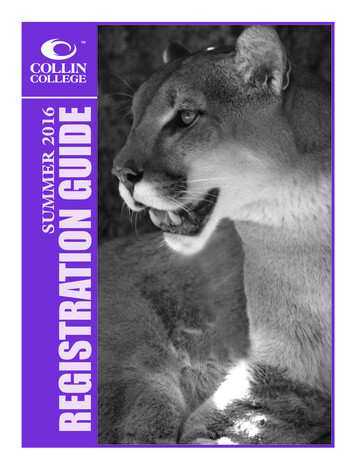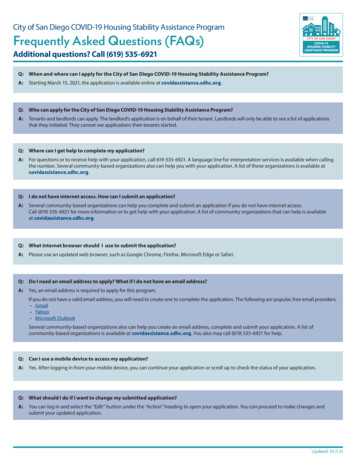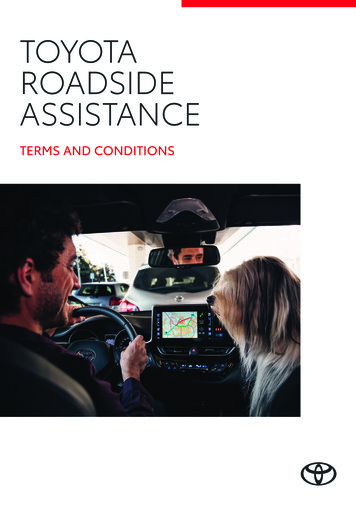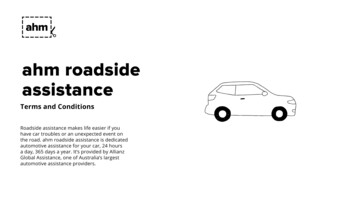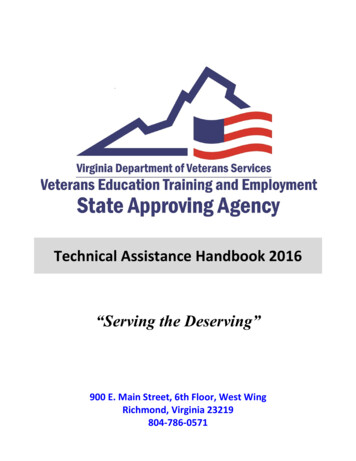
Transcription
Technical Assistance Handbook 2016“Serving the Deserving”900 E. Main Street, 6th Floor, West WingRichmond, Virginia 23219804-786-0571
Table of ContentsSAA InformationGlossary/AbbreviationsDifference Between the SAA and the DVAApproval RevisionsDual ObjectivesNew Catalog ApprovalApproval of New BranchMiscellaneous Approval IssuesChange of OwnershipTypes of School VisitsThe Role of the Certifying OfficialCompliance SurveyUseful Web SitesVirginia Military Survivors and Dependents Education Program (VMSDEP)SAA Aplication FormsApplication for Revised ApprovalRequest for Approval of Dual ObjectiveDeemed Approved Degree Granting Insitution Catalog Approval ReviewDegree Granting Institution Catalog Approval RequestNon-College Degree Institution Catalog Approval RequestPage 62
VETERANS EDUCATION BENEFITS-WHERE TO GO FOR HELPINFORMATION AND QUESTIONSVirginia Department of Veterans ServicesState Approving Agency for Veterans Education, Training and Employment900 E. Main Street, Sixth Floor, West WingRichmond, Virginia 23219-3513DirectorAnnie Walker(804) 225-2721annie.walker@dvs.virginia.govAssistant DirectorMartina Murray(804) 225-2720martina.murray@dvs.virginia.govSenior Regional ManagerTramaine Carroll-Payne(804) ional ManagersPhillip Clayberg(804) s ManagerChris Mackey(804) 786-0571chris.mackey@dvs.virginia.govCS Support SpecialistHelen McClure(804) 225-2298helen.mcclure@dvs.virginia.govQUESTIONS CONCERNING VA REGULATIONS AND REPORTING PROCEDURESEducation Liaison Officer (ELR)James Quesenberry ELR 314-22Department of Veterans AffairsRoanoke RPO210 Franklin Rd., SWRoanoke, VA 24011(Office) (540) 597-1689 & (Fax) (540) 597-1794james.quesenberry@va.govPROCESSING OF CLAIMS AND CERTIFICATIONSDegree and Non-Degree (Certificates)Buffalo Regional Processing Office (RPO)P.O. Box 4616Buffalo, NY 14240-4616Fax (716-551-3296)Flight, OJT/Apprenticeship, CorrespondenceBuffalo Regional Processing Office (RPO)Education Hard CopyP.O. Box 21Buffalo, NY 14240-0021Education Benefit Questions (For School Officials, Students and the General Public)Internet: www.gibill.va.gov (Link: “Ask a Question”) (For All)(School Officials Only) – (Create an Account) in subject area show “School Official”School Officials Inquiries-For the Toll-Free number contact your SAA Regional ManagerToll Free Call: 1-888-GIBILL1 (1-888-442-4551)Monthly Phone Certification Toll Free – (1-877- 823-2378)Forms may also be found at: http://www.va.gov/vaforms/search action.aspPage 3
GLOSSARY AND ABBREVIATIONSAccrediting AgencyA nationally recognized agency or association which the U.S. Secretary of Education determines to be a reliableauthority as to the quality of training offered by an educational institution. The Secretary publishes a list ofthese agencies and associations which the state approving agencies utilize for establishing that a program ofinstruction may be approved under the provisions of 38 USC 3675 as an accredited program.Accelerated PaymentAn accelerated payment is a 60% lump sum payment of tuition and fees for high cost, high technologyprograms. The payment is in lieu of regular chapter 30, 1606 and 1607 (REAP) benefits and is payable only iftuition and fees exceed 200% of what would normally be payable under chapter 30 for a given enrollmentperiodActive DutyFull-time duty in the Armed Forces. This also includes full-time duty performed by commissioned officers ofthe Public Health Service and National Oceanic and Atmospheric Administration (not including active duty fortraining).Active Duty for Training (ACDUTRA)Active duty for training in the Reserves or National Guard. This includes reservists on full-time duty fortraining purposes in the Armed Forces; members of the National Guard or Air National Guard of any state,performing full-time training duty under title 32, U.S. Code, sections 316, 502, 503, 504, or 505.Advance PaymentThe monetary allowance which may be payable to students for the first (fractional or full) and second fullmonth of enrollment. Advance payment must be requested by students and is mailed to schools before thebeginning of classes for release to students who have completed registrationAlready QualifiedA student is considered “already qualified” if he or she has previously completed a program at the same leveland in the same field of study for which application is now being made. This will not preclude the pursuit of aprogram leading to a degree at the same level with a different major or in an entirely different field. It also doesnot preclude the pursuit of subjects that may be necessary to qualify for admission into a program leading to ahigher degree or to qualify for a vocational or professional objective. A person will be considered alreadyqualified if he or she was previously employed in a job for which the course now being requested is designed toqualify the individual who completes it. For example, if the applicant is employed in sales, he or she is alreadyqualified and not eligible for enrollment in a general sales course. VA benefits are not payable for pursuit of anyprogram for which the student is already qualified. This includes courses required for re-licensing or acontinuation of licensing in a professional field.Armed ForcesThis includes the United States Army, Navy, Marine Corps, Air Force, and Coast Guard, including the reservecomponents thereof.Assignment of BenefitsAny arrangement by a school that denies the student the opportunity to control the proceeds of a check isprohibited. Section 5301(a) of title 38, U.S. Code, provides that payments of benefits due under the lawsPage 4
administered by VA shall not be assigned except as specifically authorized by law. There are no laws thatauthorize assignment of VA educational checks, either directly or indirectly.Audited CourseThe term means any credit course that a student attends as a listener only with a prior understanding betweenschool officials and the student that such attendance will not result in credit being granted toward graduation.VA education benefits are not payable for pursuit of such coursesAward LetterThe official written notice from the Department of Veterans Affairs to a student of his or her monthly rate ofpayment, the inclusive dates of payment, and remaining entitlement at the end of the award period. An awardletter is sent to a VA student whenever VA awards or changes the student’s education benefit. The awardletter is a good source of information for financial aid purposes.BDNThe Benefits Delivery Network (BDN) is composed of various components. It is VA's main processing systemfor all award and related actions. This system generates the payment information that is sent to the Treasury forproducing the benefits checks. BDN also contains the master record files for veterans and beneficiaries. It wasformerly known as the Target Delivery SystemBreak in ServiceThe term “break in service” means a period of more than 90 days between the date when an individual isreleased from active duty or otherwise receives a complete separation from active duty service and the date heor she reenters on active duty.Break PayEducational assistance benefits may be paid during the intervals between terms at a school or between termswhen transferring from one school to another while remaining in the same program. Exceptions apply, as wellas certain other restrictions in certain situations. Persons on active duty or training at less than half-time are notentitled to interval payments. (See chart on page 97).Certificate of Eligibility (COE or C/E)A Form 22-1993a which is issued to an applicant showing approval to pursue a stated program of education at aparticular institution, the remaining entitlement of the student, and the ending date of the student's eligibility.Certifying OfficialThe person(s) designated to sign enrollment certifications and other documents relating to VA benefits. Thedesignation is made on VAF 22-8794, Designation of Certifying Official(s).Certification of Delivery (COD)A Certification of Delivery (VA Form 22-1999v) is mailed to the school in a separate envelope from theadvance payment check. When the advance payment check is given to the student by the school, the COD,which contains preprinted enrollment information, must be completed by the certifying official and immediatelyreturned. Failure to do so will result in the student’s VA education benefits being suspended.Change of ProgramA change of program consists of a change in the educational, professional, or vocational objective for which theveteran or eligible person entered training and a like change in the type of courses required to attain a newobjective. This includes any change in an eligible person's program or objective which will result in a materialloss of credit or which will materially lengthen the training time necessary to complete an objective. A materialloss of credit is generally considered to be the loss of more than 12 credit hours for programs measured inPage 5
quarter or semester hours, or the loss of more than 10 per cent of the training completed for other types ofcourses. A change of program is NOT charged if a claimant completes one program, then begins a totallydifferent objective.Change of SchoolThere is no limit or restriction on change of schools for continued pursuit of the same course or programprovided the veteran or eligible person is making satisfactory progress and there is no material loss of credit.Character of DischargeAll VA benefits (with the exceptions of some insurance programs and certain medical benefits) payable toveterans or their dependents require the period of service upon which entitlement is based be terminated underconditions other than dishonorable. However, under the Montgomery GI Bill veterans must have an“Honorable” discharge to receive benefits. Discharges “under honorable conditions” or “general” do notqualify veterans for benefits. Service personnel who complete six months or less of active military service areissued “uncharacterized” discharges. If an “uncharacterized” discharge is used for reasons of service-connecteddisability or hardship, they are considered to be “Honorable” for Montgomery GI Bill purposes.CircularA publication issued by VA for distribution to regional offices and sometimes to schools as an expeditious wayto provide directives on new procedures. A circular may also be used to disseminate information regardingissues that will be pertinent for only a limited period of time.ClaimantAn individual in the process of claiming VA benefits who is potentially eligible for benefits but who has notcompleted all the necessary steps that will permit VA to determine individual eligibility and entitlement.Concurrent EnrollmentA student pursuing a degree at a school may take a course at another school because it’s at a more convenienttime, it’s less expensive, or whatever. The school that will grant the degree is the student’s primary school. Allother schools are secondary schools. If the primary school will accept the secondary school’s course as atransfer credit that applies towards completion of the student’s degree, then both the primary school and thesecondary school can certify the student to VA. The student may pursue courses at a secondary school at thesame time, concurrent, or at a different time, supplemental.Confirmed EnrollmentAn enrollment certification that is dated, signed, and mailed by the school's certifying official on or after thefirst day of a certified enrollment period.CourseAs used in this Handbook, “course” means a specific class or subject of instruction (e.g., English 110).DD Form 214The Certificate of Release or Discharge from Active Duty that is prepared at the time an individual completes aperiod of active duty in one of the Armed Forces. Former members of the Public Health Service (PHS) and ofthe National Oceanic and Atmospheric Administration (NOAA) do not receive a DD Form 214, but they doreceive comparable documents that provide necessary information concerning their active duty service.Veterans should be advised to submit copy number 4 of their DD Form 214 with a claim for VA benefits. Acertified copy may also be submitted.Page 6
Delayed Enlistment Program (DEP)A Delayed Enlistment or Delayed Entry Program allows individuals to contract to go on active duty in theArmed Forces at a later date. The periods of time of the delayed entry onto active duty vary according to thespecific program involved. For example, under DEP, the delay of entry onto active duty varies up to 270 days.In other programs, such as ROTC, the delay may be several years.Delimiting DateThe first day after a claimant's period of eligibility expires. Benefits are not payable on or after the delimitingdate. Generally, the delimiting date is ten years and one day from the veteran's last release from active duty date(RAD). The expiration date for those under Chapters 35 and 1606 is computed differently.Dependents' Educational Assistance (DEA)Education benefits payable to eligible dependents or survivors of veterans. Commonly referred to as DEA orChapter 35.DOD RecordThe Department of Veterans Affairs accesses the Department of Defense's manpower database through acomputer interface between the Defense Manpower Data Center (DMDC) in Monterey, California and the BDNSystem. This record contains information from the serviceperson's/veterans military records which VA may useto determine eligibility for Chapters 30 and 1606.Drop PeriodThe brief period at the beginning of a term officially designated for dropping courses without academicpenalty. The school's last day to drop a course will be the end of the drop period, providing it does not exceed30 days from the first day of the term.Dual EligibilityEntitlement to education benefits under two or more programs administered by VA. If an individual qualifiesfor educational assistance under two or more such programs, the total assistance available may not exceed 48months, or the equivalent in part-time benefits. A person having dual eligibility may not receive such benefitsconcurrently.ECAP (Electronic Certification Automated Program)ECAP is a computer program that processes VA-ONCE submissions. ECAP can set up claim, proposeeducation awards, and process education awards. ECAP will go as far as possible on this continuum. ECAPcopies all documents into TIMS (imagining system).Education Services Officer (ESO)This includes civilian education services officers, military career counselors, and other employees of themilitary education offices who are assigned responsibility for advising servicepersons of the educationalopportunities available to active duty personnel.Educational AssistanceThis term is generally used interchangeably with the term “education benefits.” However, under theMontgomery GI Bill - Active Duty, the term “educational assistance” means basic educational assistance,supplemental educational assistance, and all additional amounts payable, commonly called “kickers.”Eligible PersonA child, spouse, or surviving spouse of a veteran who served on active duty and who died on active duty, orwho died of a service-connected disability, or who has a total disability permanent in nature resulting from aservice-connected disability, or who died from any cause while a total and permanent service-connectedPage 7
disability was in existence. Also includes a child or a spouse of a person who is on active duty as a member ofthe Armed Forces and who now is, and, for a period of more than 90 days, has been, listed by the Secretaryconcerned as missing in action, captured in line of duty by a hostile force, or forcibly detained or interned inline of duty by a foreign government or power.ELR (Education Liaison Representative)The person at the VA regional office or Regional Processing Office responsible for education liaison andprogram approval functions. Among other things, the ELR is responsible for promptly informing schools ofchanges in policies and procedures.Enrollment PeriodThis term means an interval of time during which a veteran or eligible person is enrolled in an educationalinstitution and is pursuing his or her program of education. This term applies to each unit course or subject inthe veteran's or eligible person's program of education; i.e., quarter, semester, or full school year.EntitlementThe number of months the student will be eligible for VA education benefits. This is usually expressed in thenumbers of months and days the student will be eligible for full-time benefits, or the equivalent in part-timetraining, but also may be expressed in a dollar amount. Entitlement will vary depending on the education lawthe individual qualifies under. In no event will entitlement exceed 48 months under any combination of laws.Facility CodeThe numerical code assigned by VA to an institution specifically identifying it or one of its subdivisions. Canbe found on the WEAMS report.File NumberA seven, eight or nine-digit number assigned by VA to identify a claimant's records. The Social SecurityNumber (SSN) is the VA file number for most veterans. If a veteran was assigned an old seven or eight digit filenumber, the veteran’s SSN will cross reference the seven or eight digit file number. VA assigns a suffix to theveteran’s file number (“10” or “W”, spouse or surviving spouse, “41” or “A”, first child to apply, “42” or “B”,second child to apply, “43” or “C” third child . . .) to identify the records of an individual eligible for chapter 35benefits. A dependent’s SSN will not cross-reference a veteran’s record. To access a dependent’s record, thefile number of the veteran must be provided.GEDGeneral Educational Development (GED) certificate issued by a state-level department of education. Thecredentials issued by state-level departments of education are official documents that are acceptable as theequivalent of high school graduation diplomas. In addition, Department of Defense certificates of GEDequivalency are acceptable evidence of completion of high school educational requirements.Independent StudyA course or subject offered without any regularly scheduled, conventional classroom or laboratory sessions. ForVA purposes, such courses or subjects must be accredited and lead to a standard college degree and consist of aprescribed program of study with provision for interaction either by mail, telephone, computer/Internet, orpersonally between the student and the regularly employed faculty of the university or college. A specificapproval of these courses by the State Approving Agency is required in order for VA benefits to be authorized.Institution of Higher Learning (IHL)A college, university, technical or business school offering instruction at the postsecondary level that leads to anassociate or higher degree. The institution must be empowered by the appropriate state education authority(under state law) or accredited by a recognized accrediting agency to grant such degrees. This designation alsoPage 8
includes hospitals offering medical-dental internships or residencies without regard to whether the hospitalgrants a postsecondary degree.Interval Payment (See Break Pay)KickerAdditional money added to an individual’s education fund by the Department of Defense to encourageenlistment or retention in the Armed Forces. The kicker is added to the individual’s normal education benefit.Kickers are used for chapters 30 and 1606.Matriculated StudentA student who satisfied formal admission requirements and is recognized by the college or university as adegree-seeking student. This does not mean that an undergraduate student must have formally been acceptedinto a specific major curricular field of study before he or she may be classified as “matriculated”.MGIBRefers to either the Montgomery GI Bill - Active Duty (Chapter 30 of title 38, U.S. Code) or the MontgomeryGI Bill - Selected Reserve (Chapter 1606 of title 10, U.S. Code).Mitigating CircumstancesUnanticipated and unavoidable events beyond a student's control which are responsible for the student'sinability to complete a course or courses or which result in the student's receipt of a non-punitive grade for acourse the student did complete. Generally, a student will be required to submit corroborative evidence tosubstantiate his or her reasons for being unable to complete a course with a creditable grade.NOBEMembers of the Selected Reserve are given a Notice of Basic Eligibility (DD Form 2384, commonly referred toas a NOBE, pronounced no-be) by their National Guard or Reserve unit stating they are eligible for theMontgomery GI Bill—Selected Reserve (Chapter 1606). The primary source VA uses to establish chapter 1606eligibility is a Department of Defense (DOD) computer link, the chapter 1606 DOD Data Record. The NOBE isan alternative or supplemental document for establishing eligibility that’s primarily used to verify eligibility for120 days after the date it’s issued. If you receive a NOBE from the student filing an original application forchapter 1606 send VA a copy of the NOBE when you certify the student.Non-College Degree (NCD)The designation “NCD” is used to refer to a course or program of education or any other institutionalvocational/educational training which does not lead to a standard college degree.Non-punitive GradeA non-punitive grade is a grade that (1) doesn’t count as earned credit and that (2) doesn’t affect progressstandards for graduation. If a student completes the term and receives non-punitive grades, the non-punitivegrades must be reported to VA if they change training time. An example of a non-punitive grade is a “X” (nobasis for grade), a “NP” (no pass), or a “U” (unsatisfactory) that doesn’t count as earned credit and that isn’tcalculated into the student’s grade point average.Grades such as P (Pass) or S (Satisfactory) aren’t calculated into a student’s grade point average, but they arecounted as earned credit for graduation requirements. Since they count as earned credit towards completion ofthe student’s program, they aren’t non-punitive.Nonstandard TermA term that is shorter or longer than a standard quarter or semester. The number of instructor-student contacthours is increased proportionately each week to compensate for the difference in length. VA will computePage 9
equivalent undergraduate credits to measure courses pursued during nonstandard terms. Terms of shorter thanstandard length are referred to as accelerated terms.ObjectiveThe final educational, professional, or vocational goal of a veteran, serviceperson, or eligible person (e.g.,degree, diploma, certificate, occupation). An educational objective is one that leads to the awarding of adiploma, degree, or postdoctoral certificate that reflects educational attainment. Graduate certificate programsgenerally do not lead to an educational objective. A professional or vocational objective is one that leads to anoccupation. It may include educational courses essential to prepare for the chosen occupation.Primary School (Parent School)The primary school is the school that will grant the degree a student is pursuing. Generally, the student will beenrolled at the primary school for the majority of the program.Program of EducationA combination of subjects, unit courses, or training activities pursued at a school or training establishmentwhich is generally accepted as necessary to meet requirements for a predetermined educational, professional, orvocational objective (e.g., diploma, degree, certificate, occupation). An “approved program” is a course of studyor program of training that the appropriate State Approving Agency has determined meets the legalrequirements for payment of VA educational assistance benefits to veterans and other eligible persons.Punitive GradeA punitive grade is a grade that doesn’t count as earned credit, but is used in determining a student’s progresstoward graduation requirementsPursuitThe term “pursuit” means to work, while enrolled, toward the objective of a program of education. This workmust be in accordance with approved institutional policy and regulations, and applicable criteria of title 38,United States Code; must be necessary to reach the program's objective; and must be accomplished throughresident courses (including teacher training courses and similar courses which VA considers to be residenttraining), independent study courses, a graduate program of research in absentia, or medical/dental internshipsand residencies, nursing courses and other medical/dental specialty courses. VA considers a person whoqualifies for payment during an interval between terms or school closing, or who qualifies for payment during aholiday vacation to be in pursuit of a program of education during the interval, school closing, or holidayvacation.QuarterA division of the academic year at institutions that operate on a quarter system. Credits are earned and measuredin quarter hours. A “standard quarter” is a period of instruction usually 10 to 13 weeks long.Refresher TrainingRefresher training is a course at the elementary or secondary level to review or update material previouslycovered in a course that has been satisfactorily completed. Under some education programs, the term alsomeans training in a program of education in which the veteran is already qualified, provided that the programpursued is training to permit the veteran to update knowledge and skills and to be instructed in the technologicaladvances which have occurred in the veteran's field of employment during the veteran's period of service. Itmay be used to update skills learned either during or prior to service but not for skills first acquired afterdischarge from service. Veterans pursuing “refresher training” are not limited to “refresher courses” at theelementary or secondary level.Remedial/Deficiency CoursesPage 10
These terms refer to noncredit training at the secondary level that is required for entrance to or preparatory tothe successful pursuit of a postsecondary educational program. If secondary level training is needed for thestudent to reach a certain mastery level necessary for pursuit of a postsecondary program of education, thecourses must be listed separately on the Enrollment Certification. Upon entrance each student's academicbackground should be evaluated and, as warranted, a required noncredit program established. These secondarylevel courses may include, for example, basic English skills, fundamental math, reading, or other specialacademic assistance necessary for the student to qualify for admission. These courses may also includenoncredit secondary level training to overcome a handicap such as in speech and may be offered at a highschool, college, or other educational institution. It is the institution’s responsibility to determine ifremedial/deficiency courses are necessary.Reporting FeeVA pays an annual reporting fee to schools. This fee is intended to help defray the cost of processing VAcertifications. The annual reporting fee is based on the number of VA students, including chapter 31(Vocational Rehabilitation), certified by the school during the calendar year. The fee is 7 ( 11 if advance payrequest was processed) for each student. The reporting fee is paid as soon as possible after the end of thecalendar year.REPSRestored Entitlement Program for Survivors. Certain survivors of deceased veterans who died on active duty, orof service-connected causes incurred or aggravated prior to August 13, 1981, are eligible for benefits. Thebenefits are similar to the benefits for students and surviving spouses with children between ages 16 and 18 thatwere eliminated from the Social Security Act. The benefits are payable in addition to any other benefits towhich the family may also be entitled. The amount of benefits is based on information from the Social SecurityAdministration.Research in AbsentiaA certifying official of a school may certify a program of research pursued by a veteran or eligible person inabsentia, when the research activity is necessary for the preparation of the student's master's thesis, doctoraldissertation, or a similar treatise which is a prerequisite to the degree being pursued. The research activity mustbe defined and organized so as to enable the certifying official to evaluate the time required for its successfulpursuit, and the time certified for the research activity is independent of the time devoted to any employmentsituation in which the veteran or eligible person might be engaged.SAA (See State Approving Agency for Veterans Education Training)Selected ReserveThe term means, with respect to the Armed Forces, the Army Reserve, the Naval Reserve, the Marine CorpsReserve, the Air Force Reserve, the Coast Guard Reserve, the Army National Guard of the United States, andthe Air National Guard of the United States. The Public Health Service and the National Oceanic andAtmospheric Administration do not have Selected Reserve units.SemesterA division of the academic year at institutions that operate on a semester system calendar. Credits are earnedand measured in semester hours. A “standard semester” is a period of instruction usually 15 to 19 weeks long.ServicepersonAn individual who is currently serving on active duty. Same as “servicemember.”Standard College DegreeThe term means an associate or higher degree awarded by an institution of higher learning that is accredited as acollegiate institution by a recognized regional or national accrediting agency or an institution of higher learningPage 11
that is a “candidate” for accreditation, or an institution which is accredited by an agency recognized to accreditspecialized degree-level programs.State Approving Agency (SAA)An agency appointed by the Chief Executive of a state to approve institutiona
Degree and Non-Degree (Certificates) Flight, OJT/Apprenticeship, Correspondence Buffalo Regional Processing Office (RPO) Buffalo Regional Processing Office (RPO) P.O. Box 4616 Education Hard Copy Buffalo, NY 14240-4616 P.O. Box 21 Fax (716-551-3296) Buffalo, NY 14240-0021

